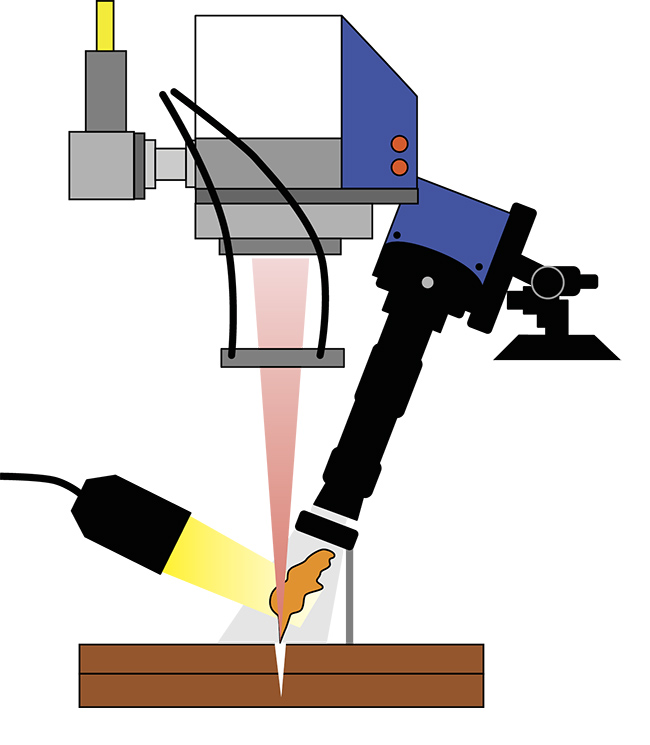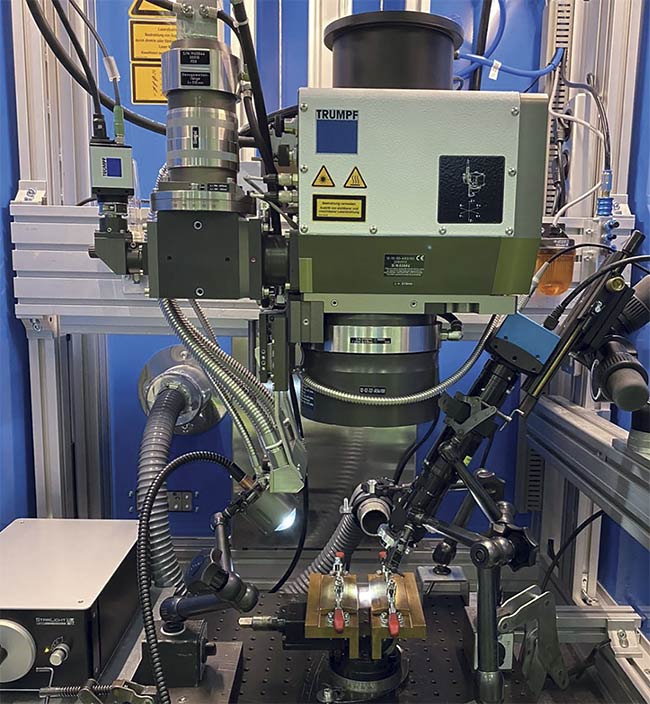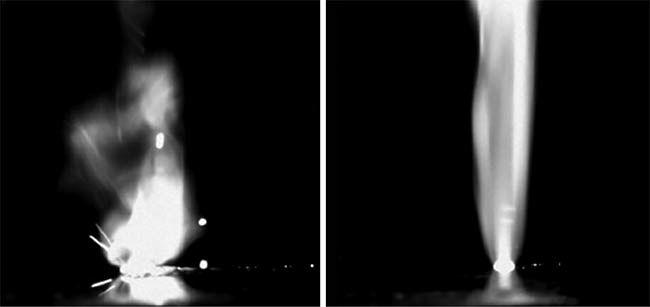HANK HOGAN, CONTRIBUTING EDITOR
As electric-powered vehicles of all kinds increasingly hit the roads, industry faces a problem: connectivity. A reliable connection between electrical components — which will need to be made thousands of times in each of the millions of cars and trucks that will eventually be produced annually worldwide — is critical for automakers. Two of the most common metals used in e-mobility and other electronics are copper and aluminum. These metals
must pass current back and forth repeatedly and with as little resistance as possible.

A schematic of the experimental setup. The laser welds copper as a camera captures high-speed images. Courtesy of Mikrotron and BLZ.
But the connection between the materials is challenging, according
to Florian Kaufmann, a researcher on the staff of the Process Technology
Department at Bayerisches Laserzentrum GmbH (BLZ), the Erlangen, Germany-based research association. “Laser welding could be a way to
get this connection realized,” he said.
Kaufmann is investigating copper laser weld mechanics and defects that may occur during processing. The studies require working in tight lab spaces and rapidly setting up for experiments. Researchers must also
capture fine details in short time intervals because they are looking specifically for fluctuations in the welding process, and other indicators that could signal the start of a problem.
The migration from DDR3 to DDR4 memory technology, which enables higher storage densities per chip, has pushed the minimum memory threshold of systems higher.
Such information can be used to
correct any issues and serve as the basis for controlling a manufacturing process. “Aims of this study usually
are the understanding of processes and process behavior, especially the
occurrence and prevention of weld seam imperfections, such as spatters,
pores, and so on, and improving
process speed,” Kaufmann said.
After considering various alternatives
for capturing image data of the laser welding process, BLZ selected a Mikrotron MotionBLITZ EoSens mini2 high-speed memory camera. It offers a resolution up to 1696 × 1710 pixels and can acquire more than 200,000 fps.
The camera is compact and runs without connecting to a computer, by
storing several seconds of image data.
Stephen Ferrell, Mikrotron’s director of business development, Americas, said the amount of data storage in the camera involves balancing several
constraints. “Cost, space, power, amount of memory control circuitry, and heat are all factors.”

The experimental setup used to study copper laser welding. A laser enters from above, and a camera (right) captures images. Courtesy of Mikrotron and BLZ.
He said the migration from DDR3 to DDR4 memory technology, which enables higher storage densities per chip, has pushed the minimum memory threshold of systems higher. Current entry-level systems come with a few gigabytes of storage, while high-end systems have more than 200 GB.
Resolution in high-speed cameras has increased, along with recording speed. In general, this market has favored higher speed over greater resolution. The majority of cameras offer only about a megapixel resolution, Ferrell said.

The top view of a weld sample. The image was taken to assess the shape of the weld seam. An experimental setup for remote laser-beam welding of metallic materials. Courtesy of Mikrotron and BLZ.
When it comes to filtering, counting, identifying, and other machine vision types of analysis, he said Mikrotron supplies data from its cameras in a format compatible with many analysis packages. End users handle the actual image processing and data extraction using their own tools. In the BLZ welding studies, the researchers use manual inspection and automated analysis to scan through the captured image data. They are looking for instabilities in the welding process, particularly with
regard to what is known as the keyhole.
In the most common form of laser welding, the energy of the laser vaporizes the metal and forms a keyhole-shaped structure in the melt pool. The keyhole thus provides important data about welding as the process happens.

An experimental setup for remote laser-beam welding of metallic materials. Courtesy of Mikrotron and BLZ.
As a result, keyhole imaging could eventually be incorporated into closed-loop control systems. Initial results,
which appeared at the September 2020 Conference on Photonic Technologies, from a system developed by a trio of researchers at the University of Erlangen-Nuremberg indicate that using a high-speed camera to examine the keyhole can determine weld location. The experimental system adaptively adjusts the beam position with sufficient accuracy to potentially be a useful process control tool. Further investigation, such as the research underway at BLZ, could produce additional information to refine this approach.
The main advantages of the current
vision system being used in the BLZ research, Kaufmann said, are the compactness of the camera and the system’s quick setup, both of which help the group to conduct research at
a faster clip. He would like to see a higher frame rate and greater sensor sensitivity, but he said he is happy with the current technology.
Kaufmann believes the vision technology is helping BLZ investigators to improve the application of laser welding in a practical setting. Their setup could form the basis for a process control tool. He said the results of the research may also lead to more reliable processes.